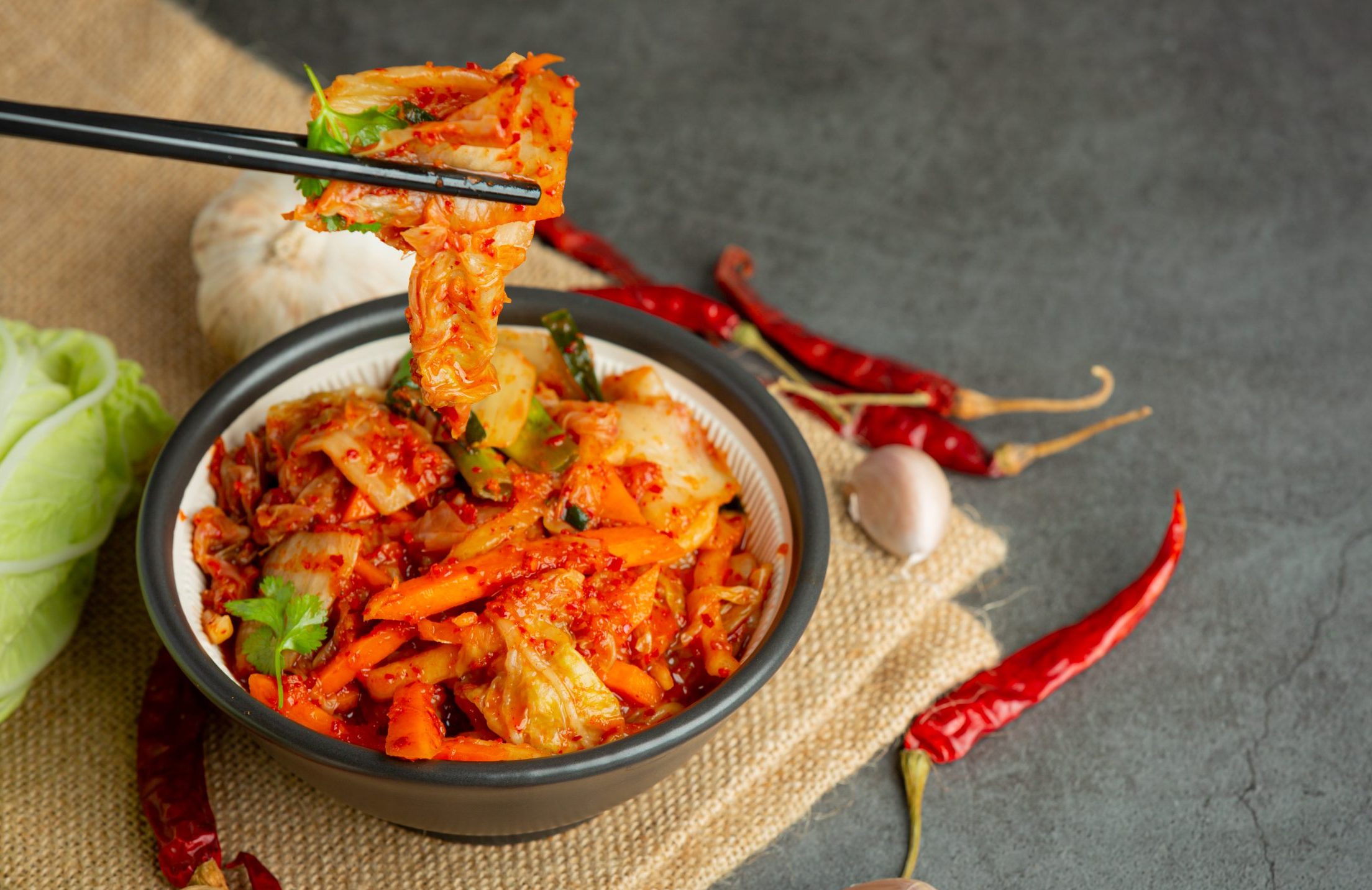The earliest evidence of fermentation dates back to 6000 B.C. discovered in the Fertile Crescent, also known as the “cradle of civilization.” Since then, practically every civilization after has at least one fermented food in its culinary legacy15. Many nations have developed distinctive tastes and customs surrounding fermentation, from Korean kimchi and Indian chutney to the sauerkraut, yoghurt, and cheese15.
Fermented foods referred to foods or beverages that have undergone controlled microbial growth as well as enzymatic conversion of food components1. Demand for fermented food such as kimchi, sauerkraut, tempeh and others is encouraged by the rising trend of veganism and inclination of consumers towards plant-based diets. Furthermore, the market is expected to be driven in the upcoming years by consumer trends in health and wellness that are expanding rapidly, as well as rising awareness of the health benefits of fermented foods and beverages8.
What is Kimchi?
Kimchi is a traditional Korean cuisine that was introduced over 3,000 years ago. The tradition of making kimchi started with the fermenting and storing of vegetables during the cold wintertime when many Koreans died due to starvation16.
Kimchi is a vegetable-based food fermented by probiotic lactic-acid bacteria (LAB), and the most loved kimchi by Korean is baechu (cabbage) kimchi (>70%)2. Because of its probiotics, physiologic nutrients and phytochemicals, kimchi is recognized as a healthy diet4. Moreover, kimchi has become a trend due to its versatility and contribution to a big and bold flavour in every meal14. Kimchi also has various types depending on the ingredients used and processing methods4.

What is Tempeh?
Tempeh is another type of fermented food produced by Rhizopus spp. fermentation of cooked soybeans6. It originated in Indonesia, where it is still the most widely consumed soy product. Tempeh’s chewy texture and unique flavour makes it an ideal meat substitute, despite the fact that it is not as well-known as tofu in the United States.

Tempeh as a Meat Replacement
Tempeh, which is rich in protein has long been viewed as a meat substitute for underprivileged communities due to the inexpensive method required for processing this food, presenting a low price with high nutritional content13. Moreover, they have become a popular meat alternative among vegetarians and vegan consumers for their health benefits, such as isoflavones and saponins7. As a meat substitute, the advantages of tempeh are as below 7.
- High protein content
- Rich in vitamin B, iron, minerals, and fibres.
- Cholesterol-free
- Gluten-free
- Vegan
- Easily digested
With a predicted CAGR of 11.81% throughout the forecasted period, tempeh is going to be the fastest-growing meat substitute consumed globally (2022-2028)8.

Rich In Probiotics
As a fermented food, kimchi and tempeh are powerful probiotics, whereby both also contain Lactobacillus plantarum which can boost the immune system and promotes healthy gut flora. Eating fermented foods can help minimize the unpleasant symptoms of a variety of gastrointestinal illnesses, including irritable bowel syndrome and colon inflammation. Therefore, keeping a balanced gut flora is crucial for your overall health3.
Source of Protective Antioxidants.
Kimchi is a rich source of antioxidants such as vitamins, carotenoids, flavonoids, and phenolic compounds while tempeh is rich in isoflavones. Accumulation of dangerous free radicals may contribute to several illnesses, such as diabetes, heart disease, and cancer. Therefore, these antioxidants work by neutralizing free radicals21. Various studies have demonstrated that isoflavones in tempeh could lower oxidative stress indicators by boosting antioxidant activity in the body. Kimchi is also a great source of antioxidants that helps in preventing oxidative stress from harming our cells. Thus, it could help to prevent or lower the risk of certain diseases. Furthermore, kimchi may help protect against cellular aging caused by oxidative stress 22.
References
1Dimidi, E., Cox, S. R., Rossi, M., & Whelan, K. (2019). Fermented Foods: Definitions and Characteristics, Impact on the Gut Microbiota and Effects on Gastrointestinal Health and Disease. Nutrients, 11(8), 1806. https://doi.org/10.3390/nu11081806
2Park, K.-Y. ., Kim, H.-Y. ., & Jeong, J.-K. . (2017). Kimchi and Its Health Benefits. Fermented Foods in Health and Disease Prevention, 477–502. https://doi.org/10.1016/b978-0-12-802309-9.00020-0
3Contributors, W. E. (2022). Health Benefits of Kimchi. WebMD. https://www.webmd.com/diet/health-benefits-kimchi#:~:text=Kimchi%20is%20full%20of%20beta
4Noh, B.-S., Seo, H.-Y., Park, W.-S., & Oh, S. (2016). Chapter 19 – Safety of Kimchi (V. Prakash, O. Martín-Belloso, L. Keener, S. Astley, S. Braun, H. McMahon, & H. Lelieveld, Eds.). ScienceDirect; Academic Press. https://doi.org/10.1016/B978-0-12-800605-4.00019-0
5Kubala, J. (2021). Ferment to Be: 9 Science-Backed Benefits of Kimchi. Greatist. https://greatist.com/health/benefits-of-kimchi#antioxidant
6Guo, M. (2009). Chapter 7 – SOY FOOD PRODUCTS AND THEIR HEALTH BENEFITS (M. Guo, Ed.). ScienceDirect; Woodhead Publishing. https://doi.org/10.1533/9781845696078.237
7Tempeh, the rich meat substitute. (2018). Schoutenfood. https://www.schoutenfood.com/news/tempeh-the-rich-meat-substitute/#:~:text=Tempeh%20is%20a%20relatively%20unknown
8Meat Substitutes Market Analysis – Industry Report – Trends, Size & Share. (n.d.). Mordon Intelligence. https://www.mordorintelligence.com/industry-reports/meat-substitutes-market#:~:text=Tempeh%20is%20likely%20to%20be
9Link, R. (2021). Why Tempeh Is Incredibly Healthy and Nutritious. Healthline. https://www.healthline.com/nutrition/tempeh#effects-on-oxidative-stress
10Russell, T. (2022). 5 Healthy Reasons to Eat Tempeh, Tofu’s Tasty, Probiotic-Packed Cousin. Real Simple. https://www.realsimple.com/health/nutrition-diet/tempeh-health-benefits
11Behera, S. S., Ray, R. C., & Zdolec, N. (2018). Lactobacillus plantarum with Functional Properties: An Approach to Increase Safety and Shelf-Life of Fermented Foods. BioMed Research International, 2018, 1–18. https://doi.org/10.1155/2018/9361614
12Rhee, S., Lee, J.-E., & Lee, C.-H. (2011). Importance of lactic acid bacteria in Asian fermented foods. Microbial Cell Factories, 10(Suppl 1), S5. https://doi.org/10.1186/1475-2859-10-s1-s5
13Karyadi, D., & Lukito, W. (2009). Beneficial Effects of Tempeh in Disease Prevention and Treatment. Nutrition Reviews, 54(11), S94–S98. https://doi.org/10.1111/j.1753-4887.1996.tb03826.x
14Saral. (2016). Kimchi: How To Use This Food Trend | FDR. Food & Drink Resources. https://www.foodanddrinkresources.com/kimchi-food-trend/#:~:text=It
15Foroutan, R. (2012). Robin Foroutan. Food & Nutrition Magazine. https://foodandnutrition.org/winter-2012/history-health-benefits-fermented-food/
16BBC Travel. (2020). How kimchi rekindled a decades-long feud. Www.bbc.com. https://www.bbc.com/travel/article/20201217-how-kimchi-rekindled-a-decades-long-feud#:~:text=%22Kimchi%20is%20a%20traditional%20Korean






